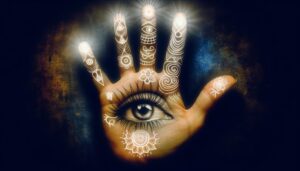What Is the Historical Meaning of the Ankh Symbol?
The Ankh symbol, originating during the early dynastic periods of ancient Egypt, signifies eternal life, immortality, and the divine connection. Characteristically depicted as a looped cross, it was central to religious rituals and funerary practices, often shown in the hands of gods and goddesses.
This emblem of the 'key of life' adorned tombs, temples, and artifacts, reflecting the Egyptian worldview and cosmic balance. In contemporary times, the Ankh finds resonance in spiritual practices, art, and pop culture, symbolizing life's continuity and mystical heritage.
To uncover its profound historical and modern relevance, explore further.
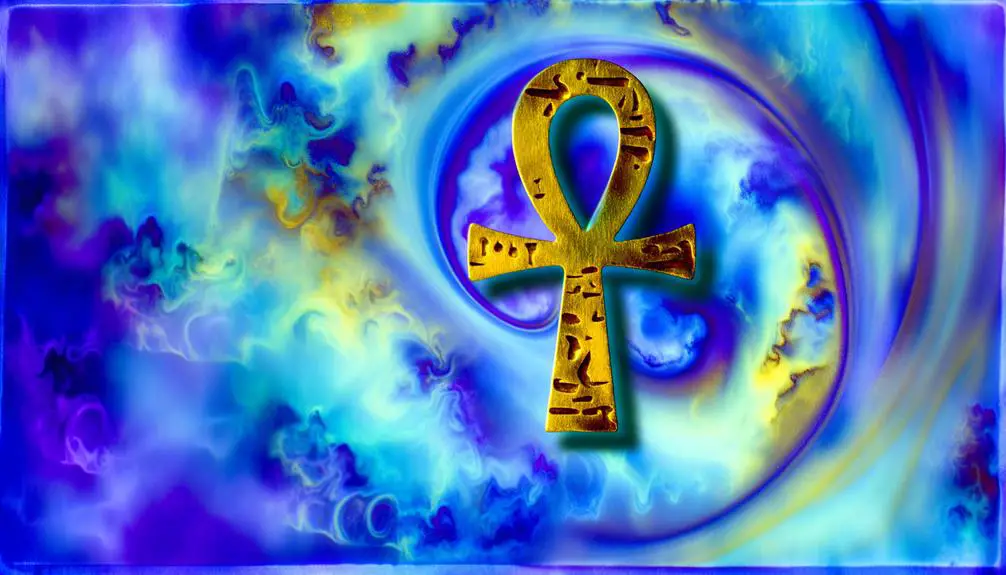
Key Takeaways
- The ankh symbol represents eternal life and immortality in ancient Egyptian culture.
- It is referred to as the 'key of life' and is associated with the divine life force.
- Deities are frequently depicted holding the ankh, symbolizing their connection to life and the cosmos.
- In modern times, the ankh is a symbol of holistic well-being and spiritual enlightenment.
- The ankh is popular in pop culture, symbolizing life, mystery, and cultural heritage.
Origins of the Ankh
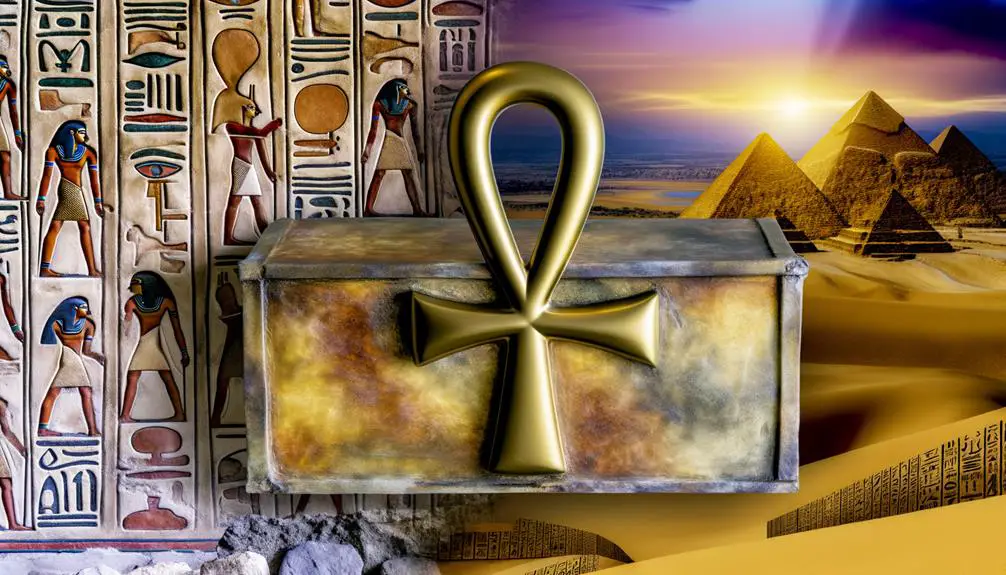
Although the precise origins of the ankh symbol are shrouded in mystery, it is widely believed to have emerged during the early dynastic periods of ancient Egypt, serving as a potent emblem of life and immortality.
Archaeological findings suggest that the ankh was already prevalent in the iconography of the First Dynasty (c. 3100–2900 BCE). Its ubiquitous presence in tombs, temples, and artifacts underscores its significance within the sociocultural context of ancient Egypt.
The symbol, often depicted in the hands of deities and pharaohs, may have evolved from early artistic representations of ceremonial implements. The ankh's distinctive shape, resembling a cross with a loop at the top, became a central motif, embodying concepts of eternal life and divine protection.
Symbolism in Ancient Egypt
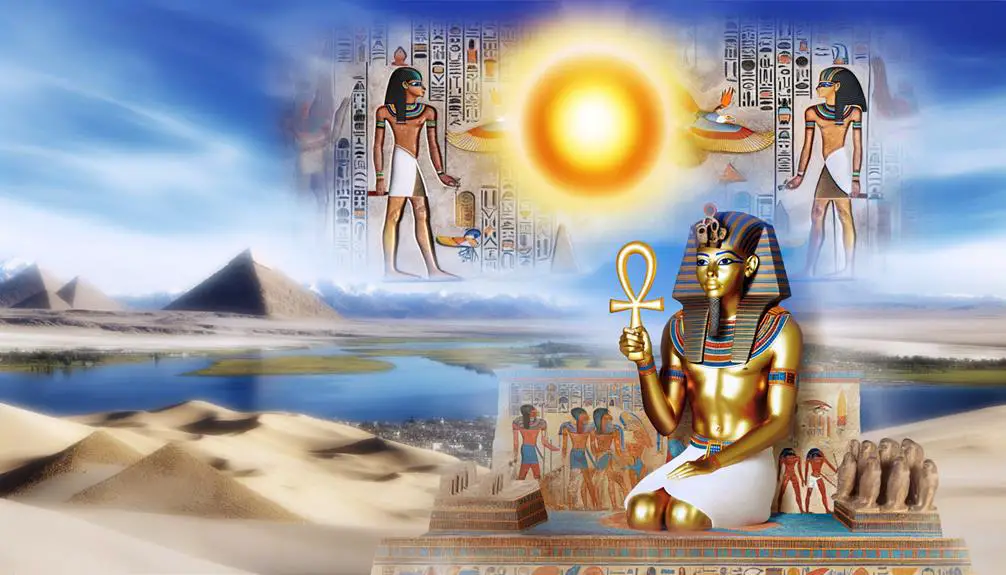
The ankh symbol's profound significance within ancient Egyptian culture is further illuminated by its intricate connections to the broader tapestry of Egyptian symbolism, which permeated various aspects of daily life, religion, and governance.
Symbols in ancient Egypt were not mere artistic expressions but were imbued with layers of meaning that reflected the civilization's values and worldview.
- Hieroglyphs: The written script itself was a complex system where each symbol conveyed both phonetic and symbolic meanings.
- Gods and Goddesses: Deities were often depicted holding or wearing symbols, each representing different aspects of life and the cosmos.
- Artifacts and Architecture: Everyday items, as well as monumental structures, were adorned with symbols to invoke protection, prosperity, and divine favor.
Understanding Egyptian symbolism therefore requires an appreciation of its multifaceted roles in conveying deeper truths.
Religious Significance
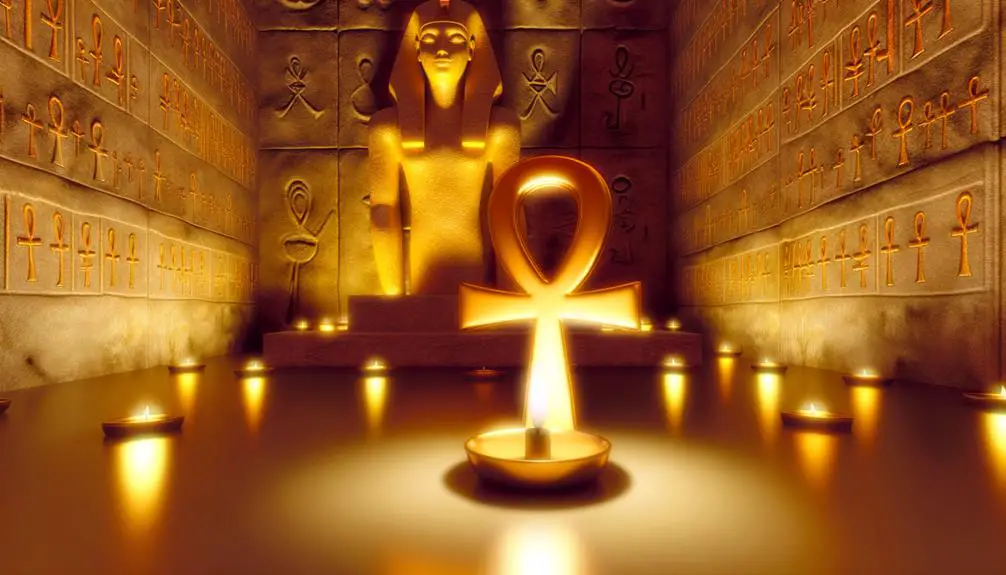
In the context of ancient Egyptian religion, the ankh symbol held profound significance as a representation of life, immortality, and the divine connection between the earthly and the spiritual domain.
Often referred to as the 'key of life,' the ankh was believed to endow the bearer with eternal life, a concept deeply embedded in the Egyptian cosmology.
Deities are frequently depicted holding the ankh, symbolizing their role as purveyors of life and protectors of the cosmic order.
This powerful emblem featured prominently in religious rituals and funerary practices, underscoring its importance in ensuring a safe passage to the afterlife.
The ankh's ubiquitous presence in tombs and temples further highlights its central role in the spiritual beliefs of ancient Egypt.
Ankh in Art and Architecture
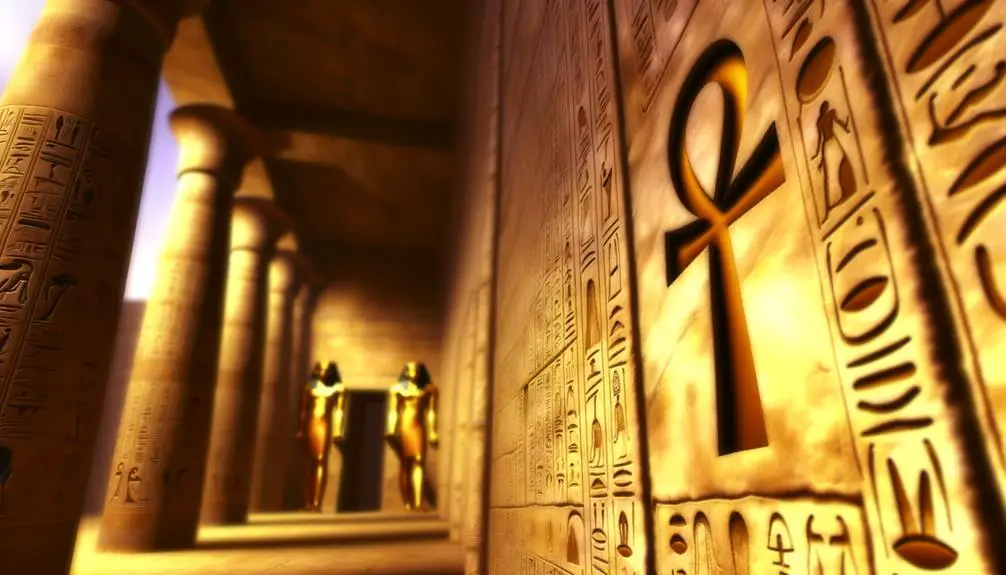
Beyond its profound religious significance, the ankh symbol permeated ancient Egyptian art and architecture, manifesting in various forms and contexts that reflected its cultural and aesthetic importance. Artists and architects integrated the ankh into their creations to symbolize life and divine protection, thereby immortalizing its essence across millennia.
- Murals and Reliefs:
The ankh frequently appeared in tomb and temple murals, often depicted being held by gods, goddesses, and pharaohs.
- Sculpture and Statuary:
Sculptors incorporated the ankh into statues, positioning it in the hands of divine figures or pharaohs to emphasize their connection to eternal life.
- Architectural Elements:
Architectural structures, such as temples and obelisks, featured the ankh in carvings and inscriptions, underscoring its pervasive symbolic resonance.
In these ways, the ankh became a cornerstone of visual and structural expression.
Connection to Deities

The ankh symbol holds profound associations with various deities in ancient Egyptian religion, representing the divine life force bestowed upon and sustained by these gods.
As a symbol of immortality, it frequently appears in the hands of gods and goddesses, signifying their eternal nature and their role in granting eternal life to mortals.
Additionally, the ankh is often depicted in sacred rituals, highlighting its significance in both the divine and earthly domains.
Divine Life Force
Central to ancient Egyptian cosmology, the ankh symbol is intimately associated with the divine life force believed to be bestowed by the gods. This powerful emblem is frequently depicted in the hands of deities, illustrating their ability to grant life and sustenance.
The ankh's shape, blending a cross with an oval loop, symbolizes the union of male and female principles, further reinforcing its connection to fertility and creation.
- Depictions with Deities: Gods and goddesses often hold the ankh, suggesting their role as life-givers.
- Ritual Use: Priests utilized the ankh in various rituals to invoke divine energies.
- Iconography: The symbol appears in tombs and temples, indicating its significance in the afterlife and daily worship.
These facets underscore the ankh's profound role in expressing the divine life force in ancient Egyptian culture.
Symbol of Immortality
Innately linked to the concept of everlasting life, the ankh symbol serves as a demonstration to the ancient Egyptians' belief in the immortality granted by their deities.
This hieroglyph, often depicted in the hands of gods like Osiris and Isis, epitomizes the divine bestowal of unending existence. The gods are frequently illustrated presenting the ankh to pharaohs, symbolizing the transference of life and protection.
Its looped top suggests the cyclical nature of life and the soul's journey beyond death. As a powerful emblem within Egyptian theology, the ankh encapsulates the assurance of perpetual life, a divine promise rooted in the pantheon's celestial hierarchy.
Hence, it stands as a symbol of the eternal connection between deity and devotee.
Sacred Ritual Connection
In addition to symbolizing immortality, the ankh held a pivotal role in sacred rituals, acting as a conduit between the deities and their followers. This ancient Egyptian symbol was often depicted in religious iconography, where gods and goddesses were shown bestowing the ankh upon pharaohs, signifying divine favor and the granting of eternal life.
The ankh's presence in ritual contexts can be understood through:
- Ceremonial Usage: Priests and priestesses utilized the ankh in various rites to invoke divine protection and blessings.
- Funerary Practices: The ankh was placed in tombs and depicted in funerary art to secure the deceased's safe passage to the afterlife.
- Amulets and Talismans: Individuals wore ankh amulets for personal protection and spiritual connection to deities.
Through these practices, the ankh transcended mere symbolism, becoming an integral element of Egyptian spiritual life.
Influence on Later Cultures
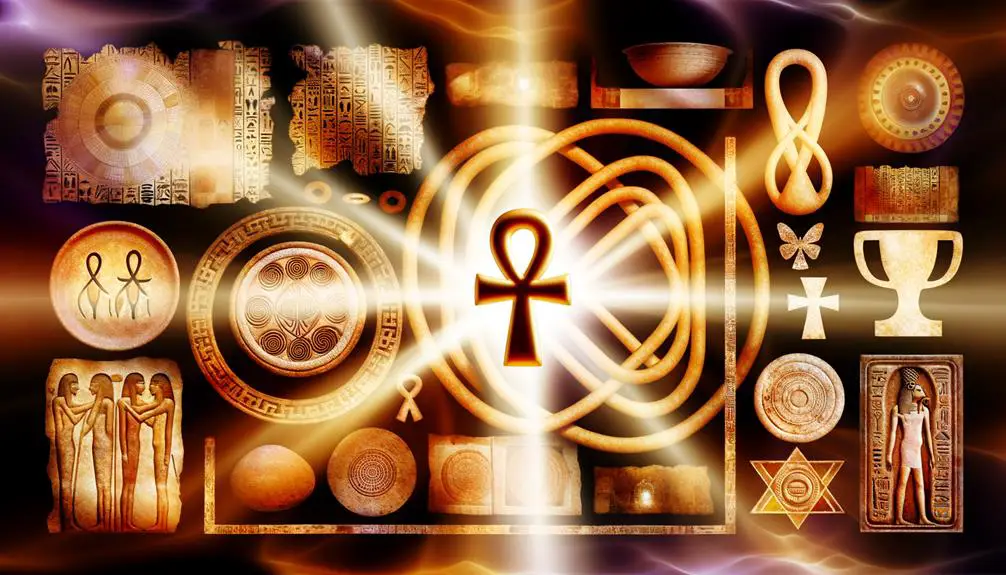
Although the ankh originated in ancient Egyptian culture, its influence extended far beyond, permeating various civilizations and leaving a lasting legacy in artistic, religious, and philosophical contexts. The symbol was adopted by early Christians, who integrated its form into the crux ansata, symbolizing eternal life. Gnostic traditions also embraced the ankh, associating it with cosmic knowledge and spiritual ascension. In modern Western esotericism, the ankh has been reinterpreted within diverse philosophical frameworks.
| Civilization | Ankh Influence |
|---|---|
| Early Christians | Crux ansata, symbol of eternal life |
| Gnostics | Cosmic knowledge, spiritual ascent |
| Roman Empire | Artistic adaptations |
| Modern Esotericism | Diverse philosophical frameworks |
| African Diaspora | Symbol of heritage and identity |
This cross-cultural adoption underscores the ankh's profound and enduring significance.
Modern Interpretations

In contemporary contexts, the ankh symbol continues to hold significant resonance across various domains. Artistic representations today see the ankh incorporated into modern designs, reflecting its timeless appeal, while its spiritual significance persists in New Age and eclectic spiritual practices.
Additionally, the ankh's presence in pop culture, from fashion to entertainment, underscores its enduring influence and adaptability.
Artistic Representations Today
Contemporary artistic representations of the ankh symbol are deeply influenced by its rich cultural heritage, integrating traditional aesthetics with modern design elements to reflect its enduring significance. Present-day artists employ various mediums to reinterpret the ankh, creating works that resonate with both historical reverence and contemporary appeal.
- Jewelry Design: Crafting ankhs using precious metals and gemstones, blending ancient symbolism with modern fashion sensibilities.
- Visual Arts: Incorporating the ankh in paintings, sculptures, and digital artwork, often juxtaposing it with modern themes and techniques.
- Tattoo Art: Popular among individuals seeking a personal connection to the symbol's historical and cultural roots, often featuring intricate designs and contemporary styles.
These interpretations often showcase modern depictions that highlight the ankh's timeless relevance in today's artistic landscape.
Spiritual Significance Now
The ankh symbol, once a powerful emblem of life and immortality in ancient Egyptian culture, continues to hold profound spiritual significance in modern times, often representing a connection to universal life force and holistic well-being.
In contemporary spiritual practices, the ankh is frequently interpreted as a symbol of eternal life and the interconnection between the physical and spiritual domains. It is embraced by various metaphysical and holistic health communities as a talisman for protection, vitality, and spiritual enlightenment.
Moreover, its association with the balance of male and female energies aligns with modern understandings of spiritual harmony. Therefore, the ankh transcends its historical roots, serving as a timeless icon that bridges ancient wisdom with contemporary spiritual pursuits.
Pop Culture Presence
Reverberating through various facets of pop culture, the ankh symbol has been embraced and reinterpreted in music, fashion, and entertainment as a multifaceted icon of life, mystery, and cultural heritage. Its contemporary allure is evident in various domains:
- Music: Artists across genres, from hip-hop to rock, incorporate the ankh in their visual aesthetics and lyrics, symbolizing eternal life and resilience.
- Fashion: Designers frequently utilize the ankh in jewelry and apparel, blending ancient symbolism with modern style, often as an emblem of unity and identity.
- Entertainment: Films and television series employ the ankh to evoke themes of immortality and mysticism, enriching narratives with historical depth.
Ankh in Popular Culture
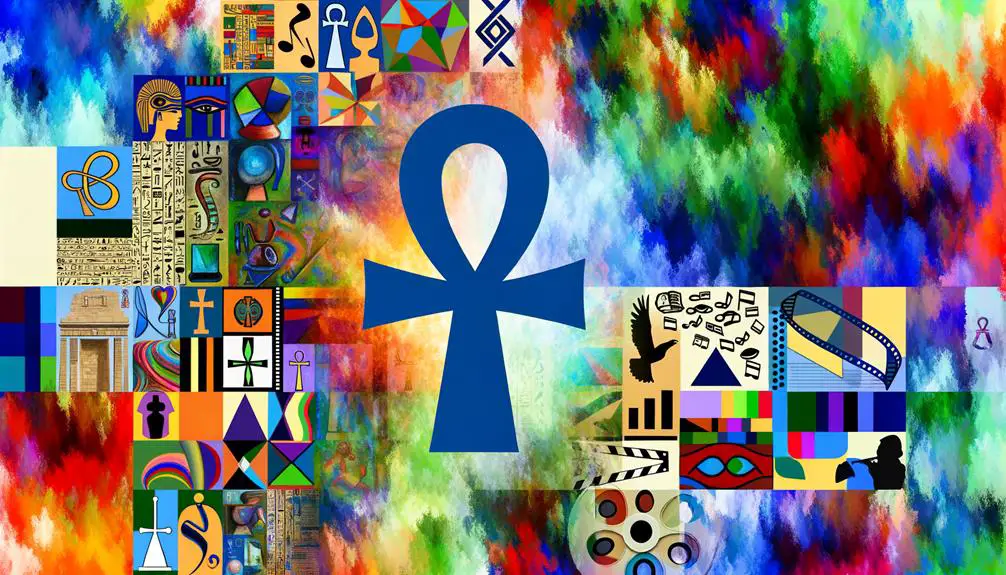
Appearing prominently in various forms of media, the ankh symbol has transcended its ancient Egyptian origins to become a pervasive icon in modern popular culture. Represented in films, television series, and literature, the ankh often conveys themes of eternal life and mystical power.
Significantly, it appears in graphic novels such as Neil Gaiman's 'The Sandman,' where it is worn by the character Death, symbolizing her role in the cycle of life and death.
Additionally, the ankh is frequently adopted in fashion and jewelry, serving as an emblem of style and identity. The symbol's integration into pop culture underscores its enduring appeal and its versatile application across various artistic and commercial domains.
Spiritual and Mystical Aspects
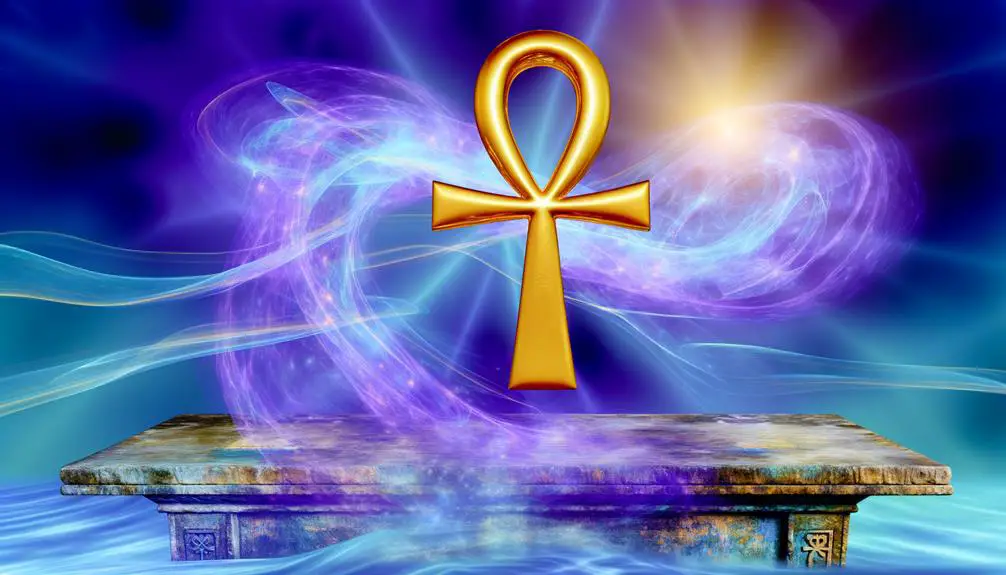
Intricately woven into the fabric of spiritual and mystical traditions, the ankh symbol is profoundly revered for its representation of life, immortality, and the interconnectedness of the universe.
In ancient Egyptian thought, the ankh served as a powerful emblem in rituals and ceremonies aimed at ensuring eternal life and divine protection. The ankh's loop symbolizes the eternal soul, while its crossbar signifies temporal existence, and the vertical line represents the path to everlasting life.
- Life and Vitality: The ankh is often depicted in the hands of deities, signifying their role in bestowing vitality.
- Mystical Union: It embodies the union of male and female principles, energetically harmonizing opposites.
- Spiritual Awakening: The symbol is used in meditation and healing practices to enhance spiritual awareness and consciousness.
Conclusion
The ankh, an ancient emblem, epitomizes enduring enigmas and eternal existence. Embedded in Egyptian ethos, it encapsulates cosmic cycles, divine dynamics, and spiritual significance.
Its prominent presence in art, architecture, and alignment with deities underscores its centrality. Transcending time, the ankh's influence infiltrates modern culture, symbolizing continuity and cosmic connection.
This sacred symbol, celebrated and scrutinized, continues to captivate contemporary curiosity, signifying a synthesis of ancient wisdom and modern mysticism.

